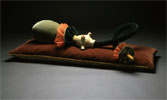works sited
Florence’s Museum of Natural History, “La Specola”, was officially inaugurated in 1775. Situated in a block of buildings next to the Pitti Palace that remain its present-day location, it was designated to house a range of art objects, natural treasures and books that that had been collected by several generations of Medici. It was the only scientific museum specifically created for the public and maintained regular “open” hours from the start. Among the holdings of “La Specola” was a superb collection of anatomic waxes that today occupies ten of its thirty-four rooms. The art of forming anatomic models from wax was introduced in Florence in the early seventeenth century. The life-like models, reflecting the scientific understanding of the time, were created in order to teach anatomy without having to directly observe a cadaver. Besides their value as teaching tools, the wax models possess an extraordinary artistic value, owing to precise craftsmanship and a unique and quirky system of display: many specimens rest upon pillows and drapes of once-luxurious fabric and recline in ornate vitrines of the Baroque style.
My own appreciation of this distinctive European decorative tradition was represented by my “Turkish Bath” series of the 1990’s, inspired by the painting Le bain turc by Jean-Auguste-Dominique Ingres. Ingres’ painting was his foremost portrayal of the “harem” theme, a popular subject in nineteenth century Europe for the opportunity it provided to depict female nudes in exotic environments and situations of captivity. One of my intentions with the “Turkish Bath” series was to challenge the lingering modernist assumption that decoration and ornament, read as “feminine” and “ bourgeois”, were enemies of “high art”. The mixed media objects were hybrids of symbolic male and female representation: perforated and projecting, hard and soft, inside and outside. They were loaded to evoke all manner of “female” allusions by their small size and by their multi-layered use of flocking, flounce and fabric.
When I visited “La Specola” in Florence in 2003, I was struck by the similarity of the decorative presentation of the wax anatomic models and my own series of organ-like clay forms. I am pleased to show a number of “Turkish Bath” pieces here in the glass vitrine of the Los Angeles Central Library.
- Phyllis Green
Reference: Monika During, Marta Poggesi, Encyclopaedia Anatomica: A Selection of Anatomical Wax Models, Cologne: Taschen, 2001.
